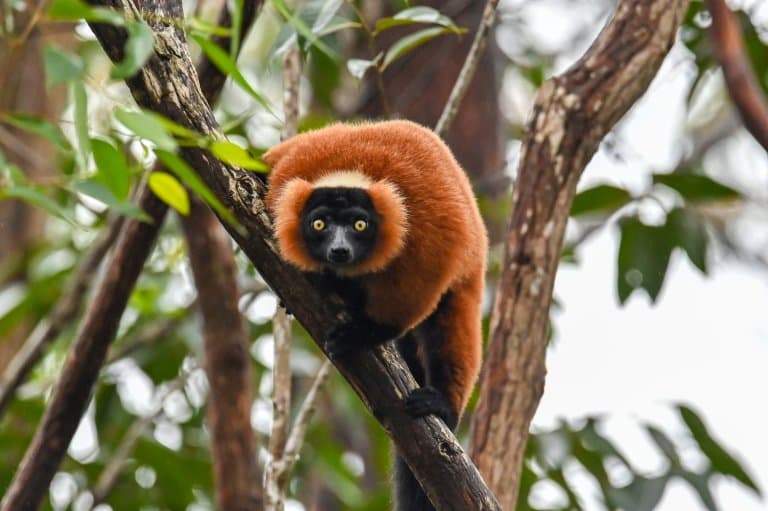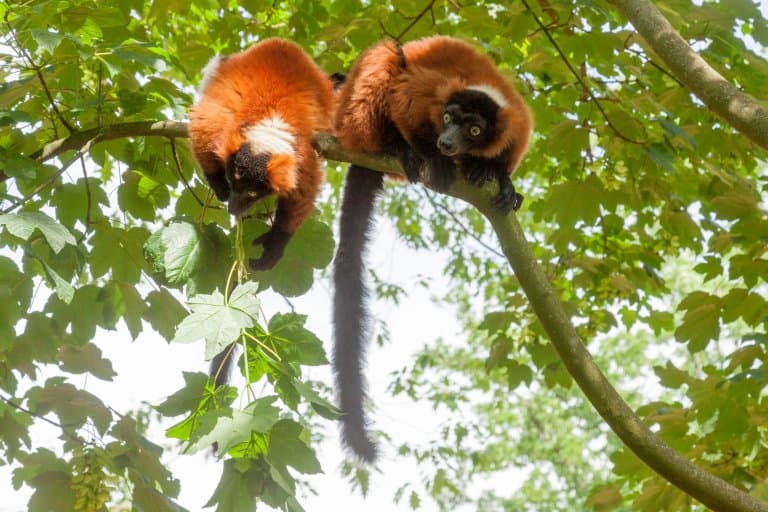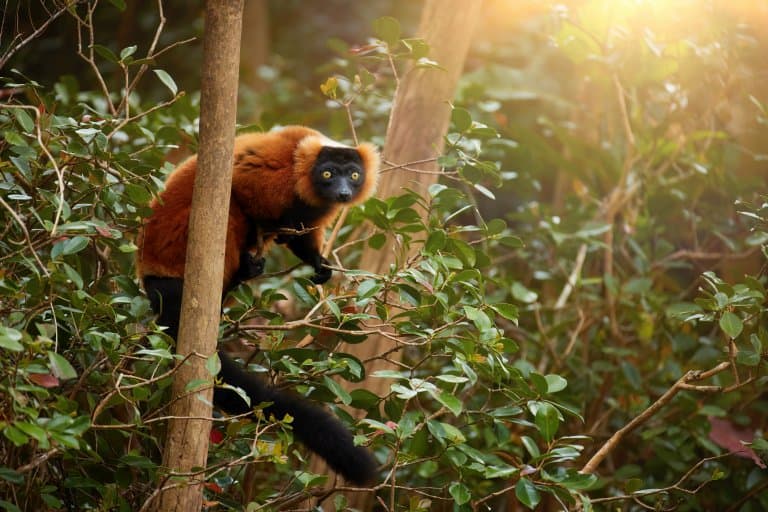Red Ruffed Lemur Profile
Madagascar houses some of the most diverse and unique animals on Earth. Sadly, many are struggling with increases in logging and illegal hunting.
One such animal is a critically endangered creature that looks like one of the Fireys from Labyrinth.
But the Red Ruffed Lemur is as real as it gets, and in serious danger. It’s one of two species of ruffed lemur, which are wet-nosed primates.

Red Ruffed Lemur Facts Overview
| Habitat: | Rainforests |
| Location: | Madagascar |
| Lifespan: | 20 years in the wild, up to around 30 in captivity |
| Size: | Around one meter (3ft) long |
| Weight: | Up to 4kg (8.8lb) |
| Color: | Auburn, with black face and tail |
| Diet: | Fruit and foliage |
| Predators: | Snakes, Large raptors, fossas |
| Top Speed: | Not recorded |
| No. of Species: |
1 |
| Conservation Status: |
Critically Endangered |
One of the biggest lemurs on the island is also one of the most threatened. These small-brained primates aren’t as dumb as they want you to think but do lean heavily on appearances.
They live in the forests of Masoala Peninsula near Maroantsetra in northeastern Madagascar, in matriarchal groups of 2–16 individuals and spend their days foraging for fruit, nectar, leaves, and pollen.
The red ruffed lemur can often be heard in the forest communicating through loud booming calls.
They are monogamous and breed strangely, and this causes some problems, but if given the chance, they could become exceptional allies in forest restoration.
Interesting Red Ruffed Lemur Facts
1. They’re one of the largest lemurs
Lemurs are a troublesome bunch for taxonomists, but currently, they’re thought to occupy five families. The largest of all is the Indri, a member of the Indriidae family.
However, of the Lemuridae family, the ruffed lemurs are the largest – growing up to 53 cm in length, with a tail that’s even longer than their body at over 60 cms!
There are two species, and this one, the Red Ruffed Lemur, is the larger and can weigh as much as a large house cat.

2. They have tiny brains
At the other end of the spectrum, lemurs are known for their little heads. Of all the primates – animals known for their relatively large brains – lemurs have the smallest.
Despite this, when their cousins, the black and white ruffed lemurs, were pitted against other primates in cognitive tests, they performed similarly to macaques.
Macaques are generally larger and heavier, with bigger brains, suggesting that tiny lemur heads aren’t a disadvantage at all.
In some studies, red-ruffed lemurs have been assessed for their ability to do simple arithmetic. Don’t be fooled though, this is simple arithmetic!
By showing a lemur a lemon, hiding the lemon behind a screen and then removing the screen to show two lemons, researchers can conclude by their level of a surprise if they even noticed a difference.
Turns out, these lemurs can count to at least 3 lemons. 1
3. They’re proud
With all that brain power, it’s surprising that they’re so pretty. And their red ruff doesn’t come easy; these lemurs are meticulous about their presentation.
These lemurs spend a significant portion of their waking hours grooming themselves or one another. But the purpose of this extends way beyond looking amazing.
Grooming strengthens social bonds and maintains hygiene in the group. With such long and glorious hair, it’s easy for parasites and dirt to get stuck up in there, so routine grooming is a great way to bond over a shared daily chore.
One key feature in this lemur, as with some other lemurs, is the comb they use.

4. They keep smart with a toothcomb
The lower incisors of the red ruffed lemur are tightly grouped, long, and straight. These collectively are known as a tooth comb, and they’re brilliant for getting out snags in a ruff.
It’s also thought that this comb helps distribute secretions from the mouth into the fur of the lemurs being groomed, as well as direct the secretions already on the fur up into the olfactory organs. 2
5. They have over 12 different calls
The Duke Lemur Centre has recorded around twelve different calls of ruffed lemurs.
Despite inhabiting different areas of Madagascar, the red ruffed lemur and the black-and-white ruffed lemur are able to understand each others calls.
6. They’re bad at reproducing
One of the reasons these animals might be struggling so much is down to their choice of reproductive strategies.
These strategies are as varied as it gets, but all involve high resource requirements. First of all, the female gives birth to a whole bunch of lemurs. Secondly, these lemurs are pretty useless and need a lot of attention.
Thirdly, parents may not step up to the task at all. For the first two months, the baby is stashed in a hole and visited occasionally for feeding.
This is a high-risk-high-reward strategy and is sometimes accompanied by co-stashing, in which both parents are involved in “hide the baby”, or a more communal arrangement where non-relatives get involved.
All of this is a bit sketchy, but it would work if they could catch a break with a stable habitat.
Ultimately, Red-ruffed lemurs like to play life on hard mode. Unfortunately, this hasn’t favoured them well in recent years. 3
7. They’re threatened by deforestation
Madagascar, like much of the African mainland, has rich deposits of precious minerals, vast amounts of high-quality timber, and various other sought-after resources. It’s also home to unique species of animals, with all the primates, 95% of the reptiles and 90% of the plants found nowhere else on Earth.
This is a dangerous combination, as precious exploitable resources like rosewood and sapphires bring in large amounts of destruction from miners and loggers.
Illegal and legal logging both threaten red-ruffed lemurs, and their population has dropped by over 80%. Agriculture and illegal hunting also contribute to their decline, and while the total number isn’t available, they’re considered critically endangered as a species.
Being unique to the island makes them impossible to rescue by translocations from other countries, so their protection in Madagascar is essential to the success of the species. 4

8. But they may have the solution
As fruit-eaters, they swallow a lot of seeds. And these seeds come out the other end more or less intact. In fact, some may come out in a better condition to germinate than they had when they went in.
Lemur scat plays a critical role in the regeneration of degraded forests by spreading seeds from plants.
Well over half the red ruffed lemur’s diet consists of fruit, and seeds from over three-quarters of these fruits make it safely into the dung pile at the end of the day.
If we as a species could just step back for a moment, ecosystem engineers like the red ruffed lemur would be more than happy to do our tree planting for us. 5
Red Ruffed Lemur Fact-File Summary
Scientific Classification
| Kingdom: | Animalia |
| Phylum: | Chordata |
| Class: | Mammalia |
| Order: | Primata |
| Family: | Lemuridae |
| Genus: | Varecia |
| Species: | Varecia Rubra |
Fact Sources & References
- Peer J. (2020), “The lemur baseline: how lemurs compare to monkeys and apes in the Primate Cognition Test Battery”, NIH.
- (2016), “THE RED RUFFED LEMUR (VARECIA RUBRA)”, Red Ruffled Lemur Blog.
- Natalie Vasey (2007), “The breeding system of wild red ruffed lemurs (Varecia rubra): a preliminary report”, Primates.
- “Red Ruffed Lemur”, IUCN Red List.
- Barbara Therese Martinez (2010), “Forest restoration in Masoala National Park, Madagascar: The contribution of the red-ruffed lemur (Varecia rubra) and the livelihoods of subsistence farmers at Ambatoladama”, University of Minnesota ProQuest Dissertations Publishing.
